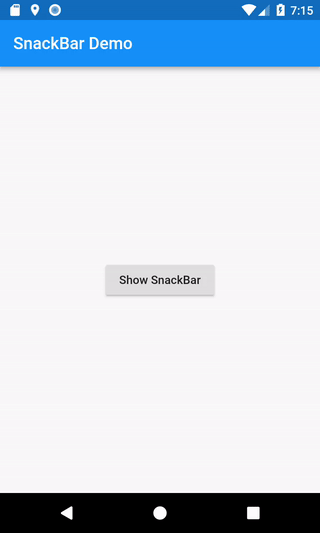Displaying SnackBars
In some cases, it can be handy to briefly inform our users when certain actions take place. For example, when a user swipes away a message in a list, we might want to inform them the message has been deleted. We might even want to give them an option to undo the action!
In Material Design, this is the job of a SnackBar.
Directions
- Create a
Scaffold - Display a
SnackBar - Provide an additional action
1. Create a Scaffold
When creating apps that follow the Material Design guidelines, we’ll want to
give our apps a consistent visual structure. In this case, we’ll need to display
the SnackBar at the bottom of the screen, without overlapping other important
Widgets, such as the FloatingActionButton!
The Scaffold Widget from the material library creates this visual structure for us and ensures important Widgets don’t overlap!
new Scaffold(
appBar: new AppBar(
title: new Text('SnackBar Demo'),
),
body: new SnackBarPage(), // We'll fill this in below!
);
2. Display a SnackBar
With the Scaffold in place, we can display a SnackBar! First, we need to
create a SnackBar, then display it using the Scaffold.
final snackBar = new SnackBar(content: new Text('Yay! A SnackBar!'));
// Find the Scaffold in the Widget tree and use it to show a SnackBar
Scaffold.of(context).showSnackBar(snackBar);
3. Provide an additional action
In some cases, we might want to provide an additional action to the user when the SnackBar is displayed. For example, if they’ve accidentally deleted a message, we could provide an action to undo that change.
To achieve this, we can provide an additional action to the SnackBar Widget.
final snackBar = new SnackBar(
content: new Text('Yay! A SnackBar!'),
action: new SnackBarAction(
label: 'Undo',
onPressed: () {
// Some code to undo the change!
},
),
);
Complete Example
Note: In this example, we’ll show the SnackBar when a user taps on a button. For more information on working with user input, please see the Handling Gestures section of the Cookbook.
import 'package:flutter/material.dart';
void main() => runApp(new SnackBarDemo());
class SnackBarDemo extends StatelessWidget {
@override
Widget build(BuildContext context) {
return new MaterialApp(
title: 'SnackBar Demo',
home: new Scaffold(
appBar: new AppBar(
title: new Text('SnackBar Demo'),
),
body: new SnackBarPage(),
),
);
}
}
class SnackBarPage extends StatelessWidget {
@override
Widget build(BuildContext context) {
return new Center(
child: new RaisedButton(
onPressed: () {
final snackBar = new SnackBar(
content: new Text('Yay! A SnackBar!'),
action: new SnackBarAction(
label: 'Undo',
onPressed: () {
// Some code to undo the change!
},
),
);
// Find the Scaffold in the Widget tree and use it to show a SnackBar!
Scaffold.of(context).showSnackBar(snackBar);
},
child: new Text('Show SnackBar'),
),
);
}
}
